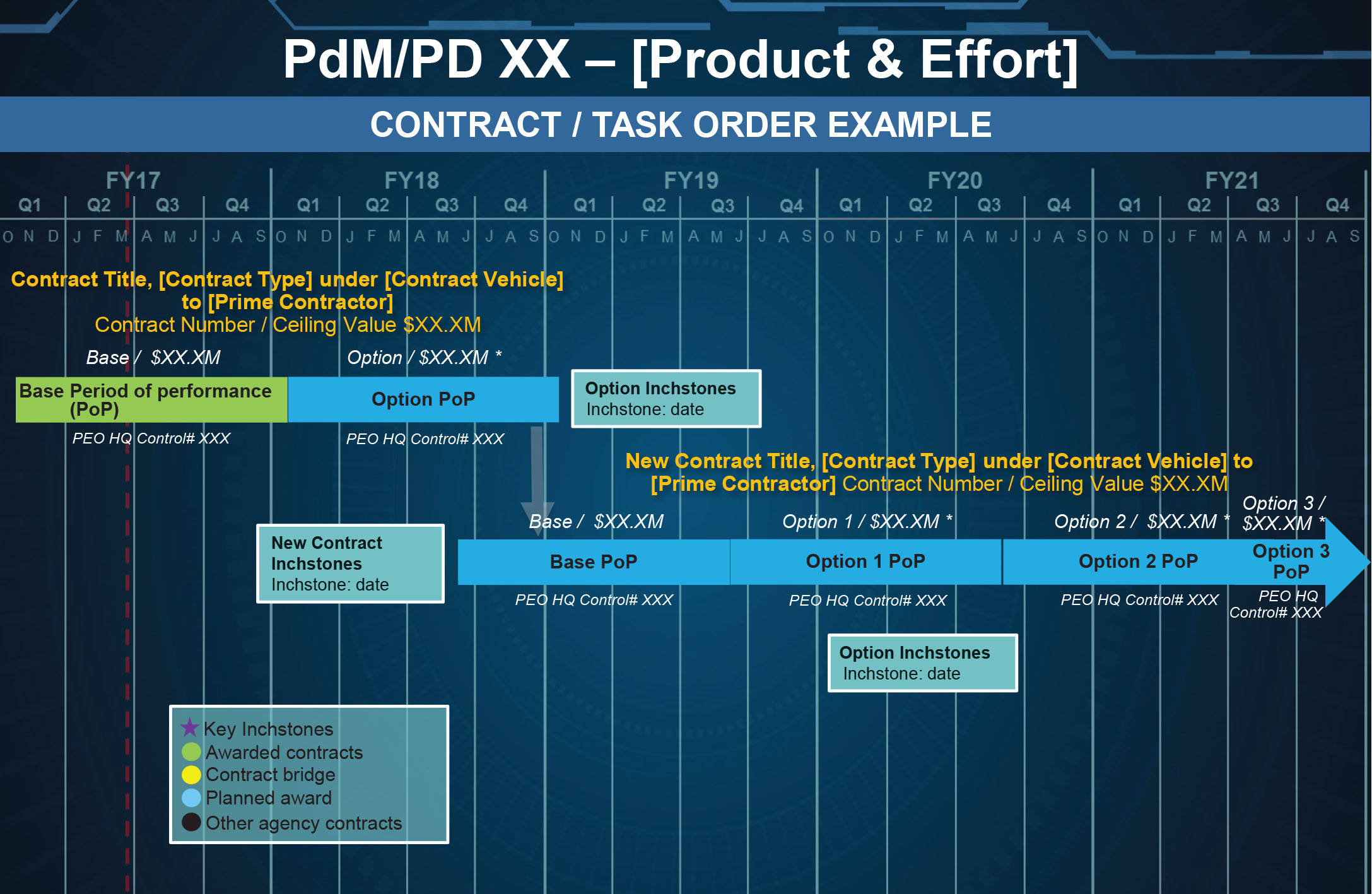
Delivering now
PEO IEW&S contract planning tool literally shows the way to successful execution of myriad actions at once.
by Mr. John Higgins
“Deliver now” has become an unofficial motto of the Program Executive Office for Intelligence, Electronic Warfare and Sensors (PEO IEW&S). So what does that mean?
If you’ve heard the phrase “live in the now,” you have an idea. But PEO IEW&S deals with a very specific part of “now”—the now where our warfighters are at risk. In order to keep pace with threats from the intensely detail-oriented vantage point of contracting, the PEO headquarters’ Contract Planning Division has implemented several tools to help program managers (PMs) understand and plan for their current and future contract needs. The most far-reaching of these tools—one that informs all the others—is the Contract Management Review Board, which brings a more proactive focus on procurement action lead time and allows for timely contract awards to prevent gaps in delivering essential requirements to the warfighter.
To a great extent, this approach bears the influence of Maj. Gen. Kirk F. Vollmecke, program executive officer since April 2016, who has held a variety of leadership positions in theater and stateside in which he was responsible for ensuring that contracts delivered as promised. Before coming to PEO IEW&S, Vollmecke was deputy commanding general for the Combined Security Transition Command – Afghanistan, overseeing the security assistance program for the Afghan National Security Forces . He has also served as the commanding general of the U.S. Army Mission and Installation Contracting Command and deputy to the deputy assistant secretary of the Army for procurement, so he appreciates timely and accurate contracting.
“Vollmecke knows it is important, as he has seen death in wartime efforts because PWSs [performance work statements] weren’t written correctly,” said Mardel Wojciechowski, chief of the Contract Planning Division. “He takes that to heart. He lived it. That is why we take the time to technically write our PWSs to be cogent and succinct and hold the contractors accountable.”
MAPPING THE PATH
To that end, under Vollmecke’s guidance, the team created the Contract Management Review Board. It’s a kind of virtual whiteboard, where all the stakeholders have access to a living document on a network. “It’s very visual, so even if someone doesn’t know contracting, they can look at that flowchart and understand where the PM is with that program and that contract action,” said Wojciechowski. “Users can see when it’s due to award, when the follow-on is due, if there’s an option to be exercised, and determine if they’re going to need any type of extension.”
The board facilitates interaction among the various offices involved in a contract. It allows the requiring activity, such as a PM, a PEO or the U.S. Army Contracting Command, along with legal staff and the competition advocate, to get involved early and buy in to a timeline, said Kim Nugent, an acquisition management specialist on the contract planning team. “Bad news does not get better with time,” Nugent noted. That oft-heard saying is one reason the board exists; it brings any issues to the surface so that all parties can facilitate a solution, she said.
The Contract Management Review Board is updated quarterly. The charts are prepared by the PMs and presented in person to the deputy PEO at least twice a year, sometimes more. Who puts the board together is handled on a case-by-case basis at each PM. Typically the O-5 staff will complete the charts for their products, and the O-6 staff will consolidate them into one submission for each PM.
The board “also shows the progress of the documents that comprise an [acquisition requirements package] and can be the first indicator that a contract award will slip if not prepared in a timely manner,” said Nugent.

This screenshot from the Contract Management Review Board, with contract specifics removed, represents a product or project manager’s current and projected contracts for a five-year period. The five-year period was chosen to allow users to ensure proper transitions between periods of performance by tracking when contracts are due to expire and planning for follow-on acquisition requirement packages. The system is updated in real time so that users track the most accurate information. The dotted red line on the left marks the current date, and the key in the bottom left corner identifies which contracts have been awarded and which are in the planning stages. The down arrow at the beginning of FY19 indicates the date that the first effort is scheduled to transition to the next project award below. (Image by Justin Rakowski, PEO IEW&S)
TRIMMING THE FAT
The success of this new tool is clearly measurable. “One thing that we’ve noticed is a reduction in bridge contracts,” that is, contracts that extend lead or funding time for a certain product’s development, said Jesse LeFever, a procurement coordinator on Wojciechowski’s team. “That’s helpful not only to us but also to the PMs, because we’re all doing less duplication of work.” The number of bridge contracts decreased from 37 in FY15 to only four in FY18. Additionally, reducing time spent on the bridge actions gives PMs more time to focus on high-quality follow-on acquisition requirements packages.
In preparing charts for the board, the PM must pay special attention to procurement action lead time, which is a general outline of the required time to award a contract from start to finish, including three major milestones along the way. Phase I is the period between establishment of contract by the integrated product team and draft acquisition requirements package approval. Phase II is the period between draft acquisition requirements package approval and request for proposal (RFP) release; Phase III is the number of days from RFP release to contract award.
Further, the team has seen value in making five-year contracts the standard as much as possible.
“It’s very important because the [procurement action lead time] to put a new contract package together is a two-year period,” said LeFever. “So if the PM awards a three-year contract, there is only a one-year gap before you are starting over. By doing five- to 10-year contracts, you’re not just doing the churn constantly.
“Before, if you had a current contract that’s going to end in, let’s say, March, and your new contract isn’t going to be awarded in time, not only are you creating all the documentation for the new contract, you would also have to create additional, separate documentation to extend the current efforts in order to be able to meet your requirements,” LeFever said.

Dr. Bruce D. Jette, right, was confirmed by the United States Senate as the Assistant Secretary of the Army for Acquisition, Logistics and Technology (ASA(ALT)) on December 20, 2017, and sworn into office on January 2, 2018. In this position, he serves as the Army Acquisition Executive, the Senior Procurement Executive, the Science Advisor to the Secretary of the Army, and the Army’s Senior Research and Development official. He also has principal responsibility for all Department of the Army matters related to logistics. On Jan. 31, 2018, Jette took a quick tour of Program Executive office Intelligence, Electronic Warfare & Sensors, giving personnel his concepts of what Acquisition does well, what it can do better and what it might need to do in the future. He gave a coin to Kim Nugent, left, an Acquisition Management specialist for Program Manager Terrestrial Sensors, for her achievements in contracting and streamlining processes. Mardel Wojciechowski, center, the Contract Planning Division Chief, saw to it that Kim was given a coin by the ASA ALT. (U.S. Army Photo/John Higgins)
CONCLUSION
The board “allows the PM to see a pictorial view of contract coverage over a five-year period.” said Nugent. “In addition, it shows major inch-stones, which act as leading indicators to timely contract award.” Those inch-stones—so named because they are necessary steps between milestones—bring clarity to a highly complex process, allowing even nonexperts to see the bigger picture. Everyone’s “piece” of a contract process is more clearly laid out before them, making it easy to see where they fit in the bigger picture. And the bigger picture is how a PEO must plan.
“The PEO has tried to instill and empower the PMs to think long-term, plan far ahead,” said Wojciechowski. “He said, ‘I know that you don’t think you should plan today because you don’t have the money. That’s not the concept. The concept is to plan before you have the money, so that you’re prepared and postured to execute those dollars on a contract vehicle to support that mission when it’s time and keep pace with the threat.’ ”
This means focusing contract planning not only on current needs but also future needs and requirements, so that they deliver “now” even when the “now” changes.
For more information, go to the PEO IEW&S website.
JOHN HIGGINS is a public affairs writer for PEO IEW&S. He is an Iraq War veteran and former public affairs Soldier. He holds a B.A. in film production from Towson University.
This article will be published in the July – September 2018 issue of Army AL&T magazine.
Subscribe to Army AL&T News, the premier online news source for the Acquisition, Logistics, and Technology (AL&T) Workforce.







